
Italian Wines: How to Order Wine in Italy & Decode Wine Labels
April 29, 2025
Planning a trip to Italy and dreaming of sipping the perfect glass of vino? This guide to Italian wine breaks down exactly how to order wine like a local, decode those mysterious labels, and find the best bottles to try during your trip.
One of the greatest pleasures of eating in Italy is trying the country’s wine. It’s not only Italy’s national drink, Italian wines are also a national passion. With more than 1 million wine-growers around the country, Italians drink more wine than anyone else in the world.
Drinking wine in Italy is an egalitarian pursuit. Since practically everyone drinks wine, it’s not expected that only true connoisseurs will be ordering bottles. Along with the fact that Italy boasts some of the best wines in the world, that open-to-everyone attitude also makes Italy one of the best places to try out different varietals, even if you’re not an expert! And wine isn’t the only thing Italians drink; check out our blog on how to drink like an Italian to get the full run-down of Italian libations.
But, if you truly want to get the most out of drinking wine in Italy, here is our guide to Italian wine:

The grapes that make the magic happen.
Table of Contents
ToggleUnderstanding Italian Wine Culture
Although Chianti and Prosecco are perhaps the most popular Italian wines outside of the country, Italy boasts over 500 native grape varieties. A lot of vineyards have been producing wine for centuries, but very few non Italians have ever heard of them. For example, unique wines such as Nero d’Avola, Fiano, or Sagrantino don’t get a lot of attention outside of Italy, but Nero d’Avola is the most beloved wine in Sicily. Simply put, Italians love their wine as they love their city or small village. It’s a connection that lasts a lifetime and is passed down through generations.
As you read further, you’ll get a real feel about how much wine is not only enjoyed, but highly respected in Italy.
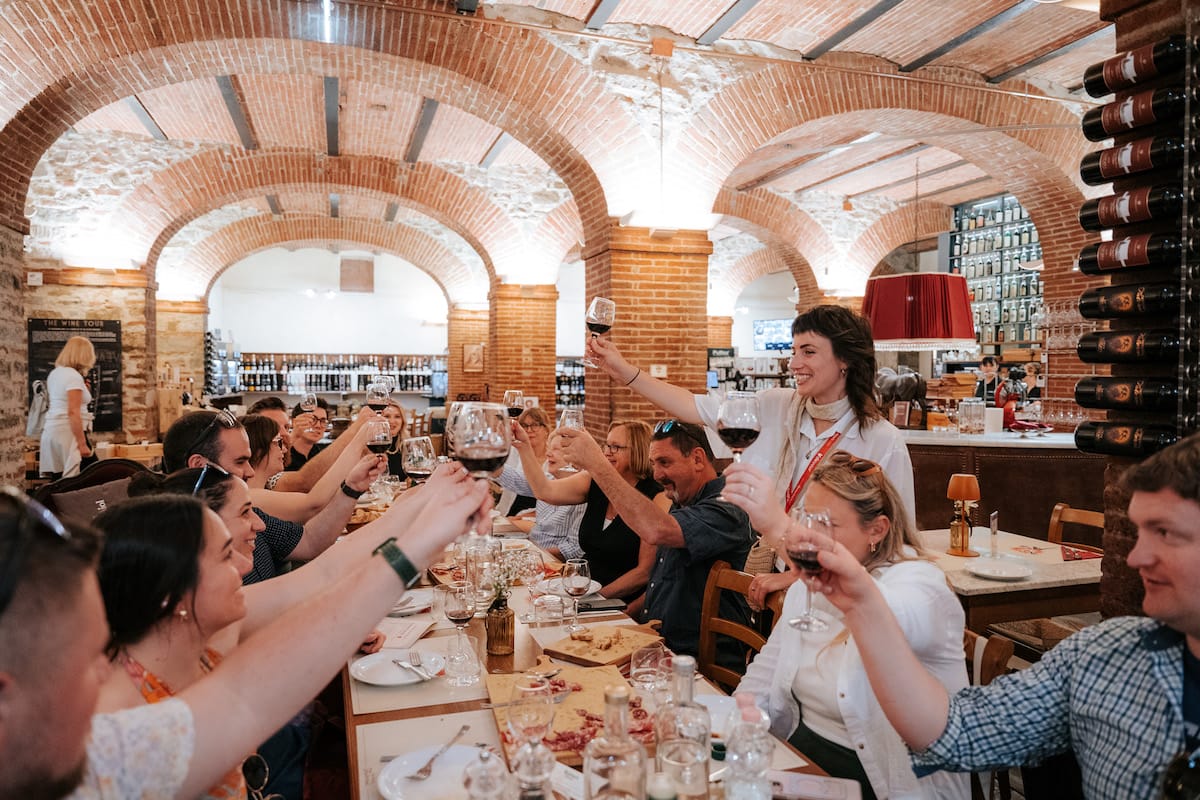
We’re not saying that all wines don’t bring happiness, but Italian wines certainly make life better.
Why Ordering Wine in Italy Feels Different
In general, great food and great wine are inesperable for most Italians. Drinking wine with lunch or dinner is not a luxury, but more of a daily staple. Additionally, ordering wine in Italy doesn’t have to be a fancy affair that breaks the bank. In fact, most house wines are not only affordable, but delicious.
Common Italian Wine Etiquette
For the most part, the etiquette of ordering and drinking wine in Italy is the same as it is elsewhere. If you’ve ordered your wine in a restaurant from a wine list, then the procedure will be the same as it is back home. The server will bring the bottle to the table.
Tasting Wine at a Restaurant
Although establishments used to assume that the man at the head of the table would taste the wine, now, most don’t. Instead, the server will ask, “Chi assaggia?” (“kee ahss-AHG-ah?”), meaning “Who tastes?” Simply point to the person to do the tasting. The server will show the label to him or her, open the bottle, and pour a small amount into his/her glass to taste.
If you’re the “taster,” remember that you’re not really tasting the just-opened bottle to check if you like it (although, if you do, murmurs of “Mmm, buono. Grazie” are always appreciated), but to see if it’s gone “off.” Although there is some discussion on the etiquette of this, in general, if the wine hasn’t spoiled, then you shouldn’t really send it back.
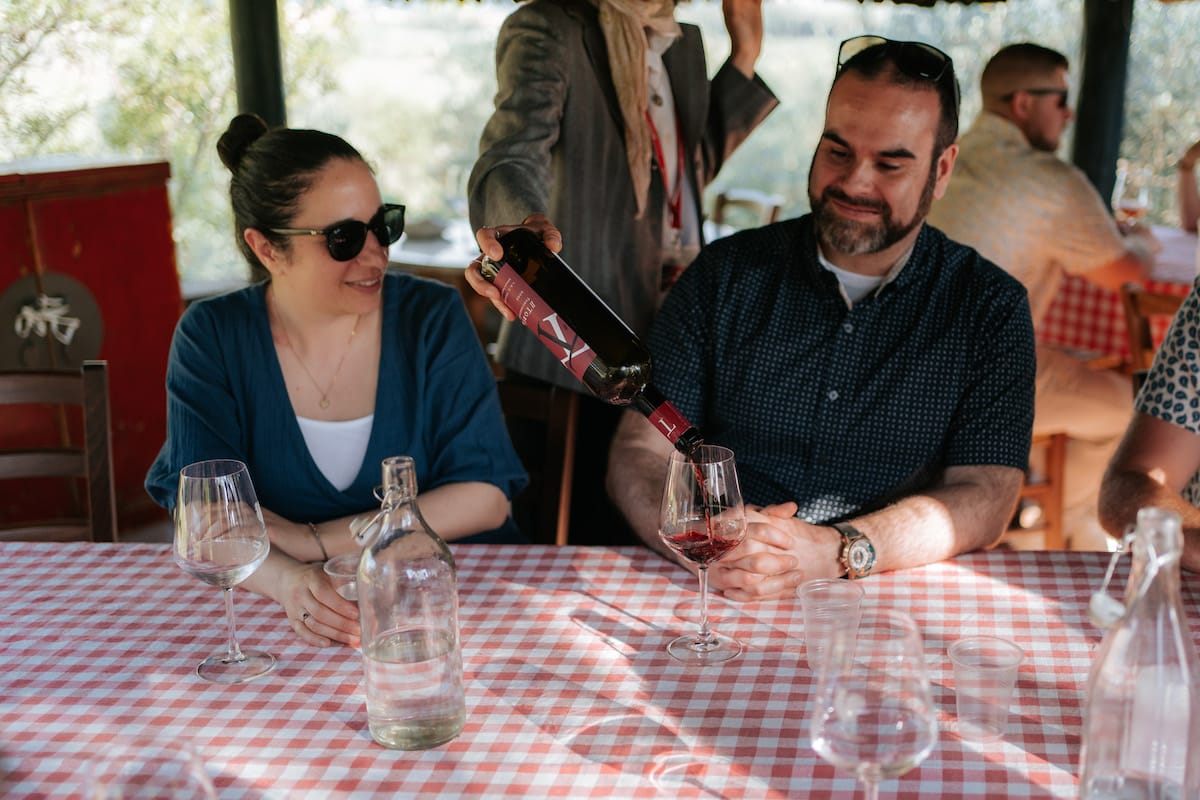
Vino, of course! But what kind of vino?
Pouring Wine
When it comes to pouring the wine, remember that in wine culture, and in Italy, glasses are usually filled to the halfway point or just under—not to the brim. And in more-casual restaurants (the kind that don’t have big wine lists, for example, but a house wine only), you might not even get wine glasses.
In that case, you’re expected to use the same glass for both water and wine, switching on and off as you go… hence not overfilling your glass with either beverage to begin with
Consider the House Wine
Small, laid-back trattorie and other restaurants might not have wine lists at all. In these cases they will still have a house wine or two. As you might guess, house wines tend to be on the cheaper side (for both the establishment and the consumer—it’s not uncommon to see a liter of house wine go for about five euros).
So it often isn’t the best wine you’ve ever had. However, you often get genuine diamonds in the rough. You see, Italian house wines tend to be locally grown and produced. They vary widely depending on region, year, weather, and even restaurant.
One of the most magical experiences is finding a little hole-in-the wall whose house wine is knock-your-socks-off good. Our favorites are a closely guarded secret but if you want to find your own, just remember not to turn your nose up when the waiter offers you house wine!

Ordering wine in Italy is a fairly straight forward process. Politeness goes a long way, and don’t be afraid of asking for recommendations.
How to Order Wine in Italy
Phrases You Can Use When Ordering Wine in Italy
Sure, lots of servers and sommeliers speak enough English to get by. But if you’re navigating a wine store or a wine menu on your own, a few little words can be a big help. Not to mention, knowing the Italian makes it fun!
The most important word? “Vino” (wine), of course! To describe what kind of wine you want, just put the adjective after the noun.
- “Vino rosso”: red wine
- “Vino bianco”: white wine
- “Vino rosato”: rosé wine
- “Vino amabile”: a medium-sweet wine
- “Vino dolce”: sweet wine
- “Vino secco”: dry wine
- “Vino abboccato”: semi-dry wine
- “Vino corposo”: a full-bodied wine
- “Vino aromatico”: aromatic wine
- “Vino frizzante”: semi-sparkling wine
As for reading the label, “azienda” means estate, “anno” is the year, and “produttore” is the producer. “Gradazione alcolica” is the alcohol percentage, and if you see “imbottigliato all’origine,” it means the wine was bottled by the producer. “Vendemmia” means harvest (i.e. the vintage), and “vitigno” means “vine.”
Helpful Phrases When Ordering Wine in Italy:
-
“Cosa mi consiglia?” (What do you recommend?)
-
“Avete qualcosa di locale?” (Do you have something local?)
How Locals Order Wine in Italy
Generally speaking, ordering wine in Italy is a casual, no fuss affair. Locals are not going to be asking about the tannins or fruity notes, etc. Sure, there are some people who like to inquire if there is anything new on the menu or something similar, but for the most part, locals tend to order el vino dell casa or house wine, which is usually very good and very cheap. Often times house wine will be served in a carafe for the table, not a bottle.
If there is a special request for wine by the region, such as a Chianti for example, they’ll be more specific and name the region:
-
“Un bicchiere di Chianti” (A glass of Chianti)
-
“Una bottiglia di Barbera” (A bottle of Barbera)
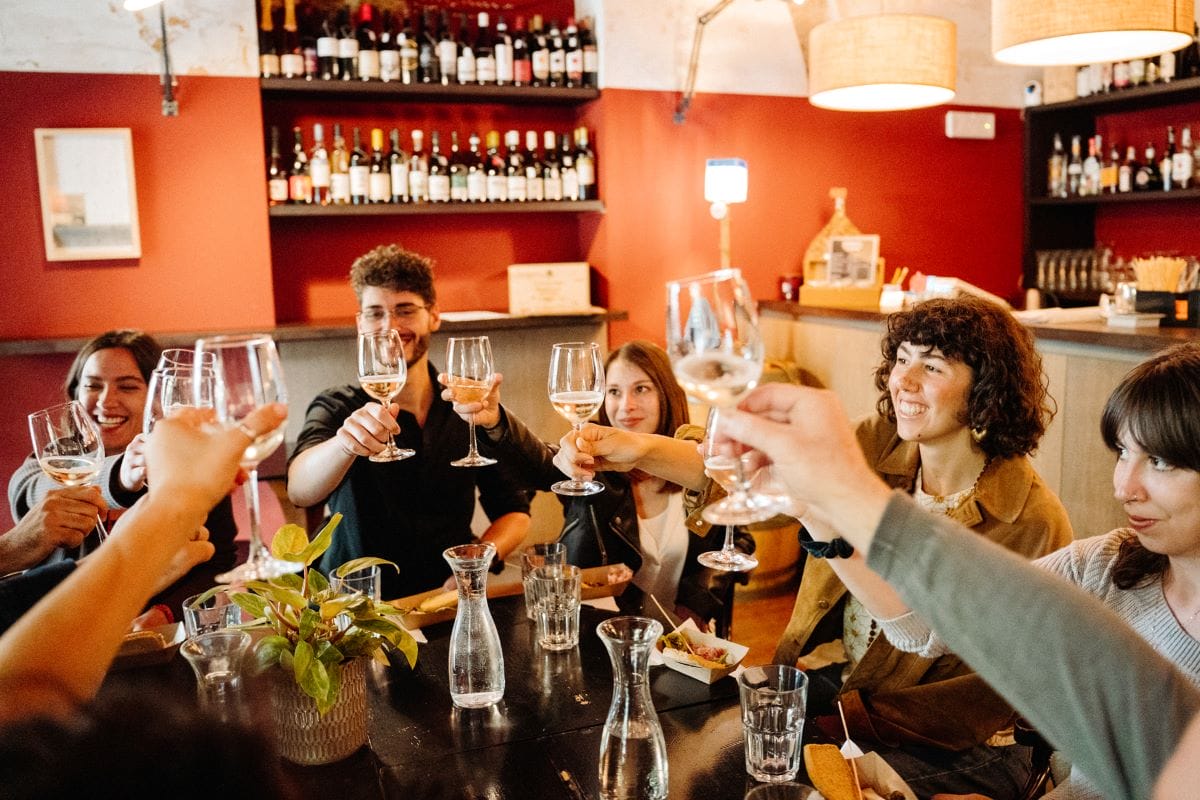
Eating, drinking and being merry is a national pastime in Italy.
Decoding Italian Wine Labels
DOC, DOCG, IGT – What Do They Mean?
Although you don’t have to be an expert, knowing your DOC from your DOCG is important while ordering wine in Italy. While it might look like alphabet soup, these different labels show the wine’s classification. In Italy, the strictest classification is DOCG (Denominazione di Origine Controllata e Garantita); these wines have to be made in DOCG-protected zones and adhere to stringent regulations. Brunello di Montalcino, for example, has DOCG protection.
The second-strictest classification is DOC (Denominazione di Origine Controllata). Like DOCG wines, DOC wines have to be made in specific zones and with particular regulations. It’s on par with France’s AOC classification (Appellation d’Origine Controlee). The next step down is IGT (Indicazione di Geografica Tipica), which describes a wine grown a particular region, but can describe any blend.
The loosest regulations are for VdT wines (Vino da Tavola), and for these, the only criteria is that they have to be made somewhere in Italy. Italy has a similar classification for food that you can read about in our article on the DOP foods of Italy. A common mistake is to assume that the strictest labels apply to the “best” wines, and vice versa. In fact, some of Italy’s best wines aren’t DOCG or even DOC. The famous “Super Tuscans,” for example, belong to the IGT category.
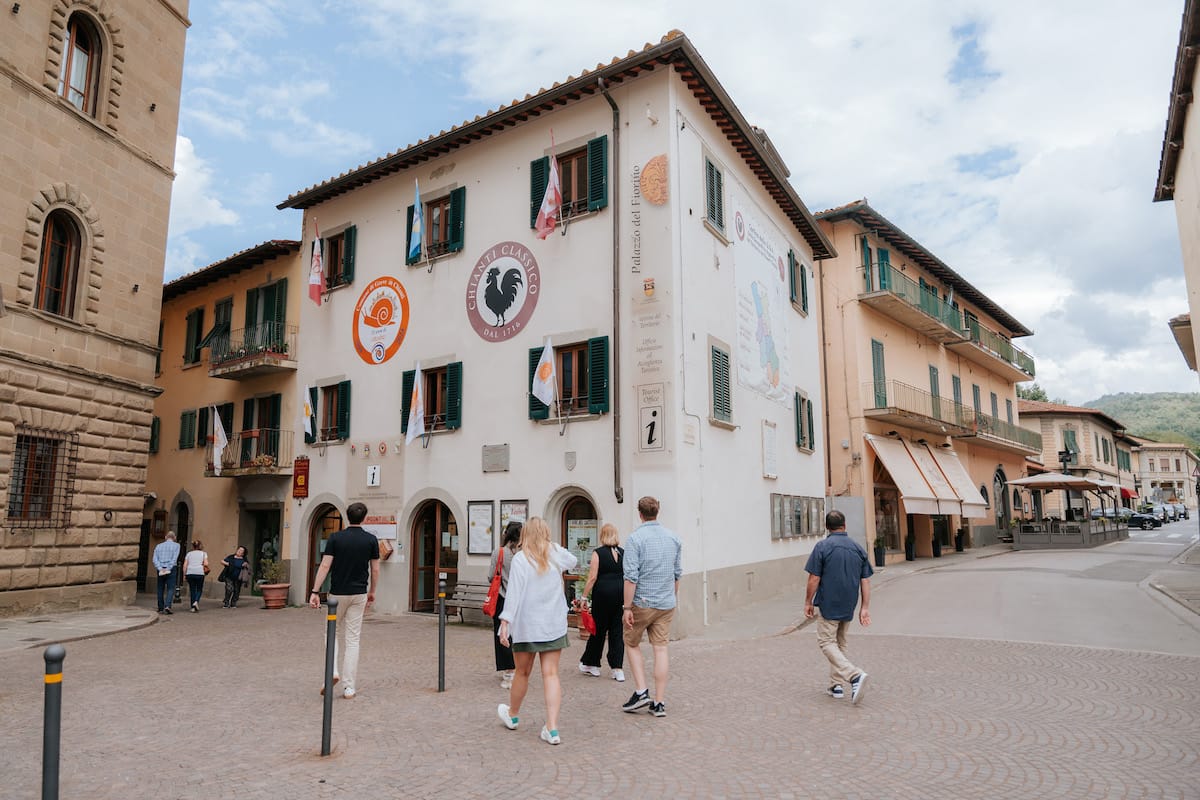
The famed black rooster is a marketing logo for Chianti that goes back to the Middle Ages.
Labeling Clues That Tell You Quality
Although Italian wine labels can look a little confusing at first, they’re pretty simple, and read a lot like French wine labels. At the top of the label, or in the biggest letters, you’ll usually see the name of the grower (in the example on the right, Giuliano Ruggeri).
After that generally come the names of the grape and region (here, the region is Montefalco). And beneath that, the vintage year, if it’s not a blend. Depending on the wine, there should also be one of the below labels: DOCG, DOC, IGT, or VdT (or it might be spelled out, as in the example to the right).
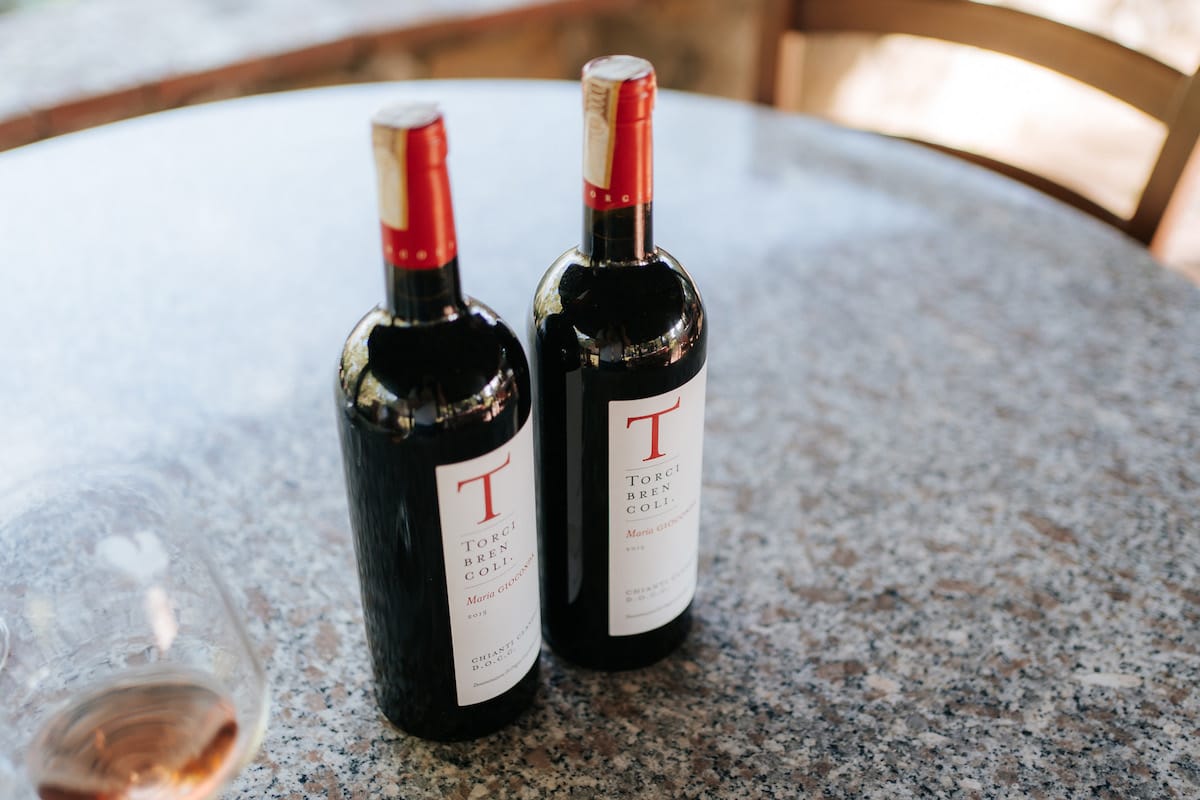
The wine label is full of information for you to understand what you’re about to get.
For a Variety of Italian Wines, Visit an Enoteca
If you really want to taste a number of varieties, on the other hand, you’ll have to head to an enoteca, or wine bar. At these establishments, the wine lists tend to be long and separated regionally and the servers well-informed. The food, rather than being the main event, is a mere detail, meant to accompany your glass (or two, or three) of wine.
Insider’s tip: Florence also has an incredible – and unusual – history of wine windows. Unique to the Tuscan city, these are openings that lead out onto the street with the sole purpose of serving wine. Invented during the Plague – over 400 years ago! – many have been revitalized and are once again in use today.
Popular Italian Wines and Regions
Italian wines, like Italian food, are intensely regional. Some, though, are particularly famous, and therefore more widely available outside their home regions.
For a basic guide to the best red and white wines by region, here are some varieties you should know:
Barolo
The most expensive wine produced in Italy, DOCG-protected Barolo is made from the Nebbiolo grape and comes from the northern region of Piedmont. It’s known as a particularly rich, full-bodied red.
Asti Spumanti
One of the most famous white wines in Italy, this is a sparkling variety that also hails from Piedmont.
Chianti
Made in the area of Chianti in Tuscany, this red wine comes at least 80% from the Sangiovese grape. Chianti is one of the best wine regions for both quality and accessibility.
To learn more about it check out our post on the best wine tasting regions of Tuscany.

A Chianti wine tour is a great way to learn about what the region has to offer.
Brunello di Montalcino
With few rivals in Italy, this DOCG-classified, Montalcino-made wine comes 100% from the Sangiovese grapes and historically has been considered Tuscany’s number-one wine.
Super Tuscans
From (you guessed it!) Tuscany, these wines are any that don’t adhere to the region’s usual blending laws, meaning they vary greatly. Some, though, are among the most expensive and renowned in the region.
Prosecco
A sparkling white wine produced in northern Italy, Prosecco is a well-known Veneto wine and favorite pre-dinner drink.
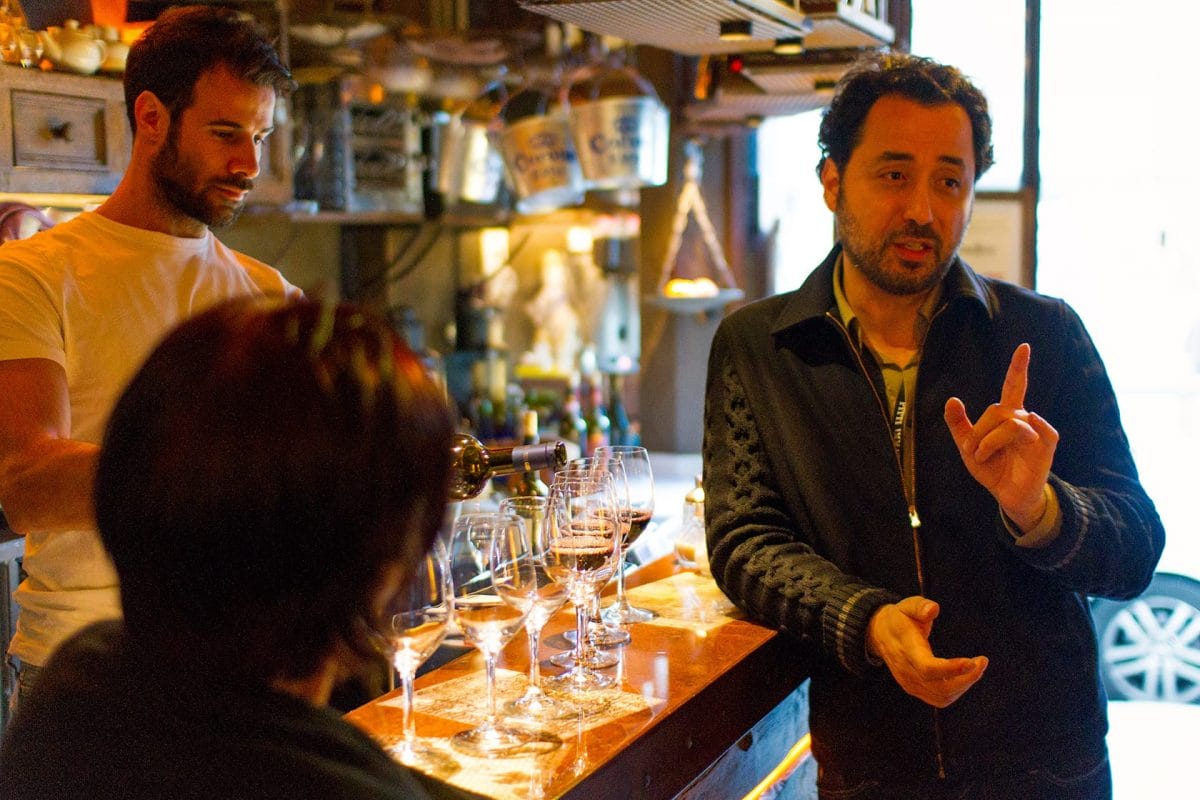
Prosecco is the perfect pre-dinner wine.
Montepulciano
Mainly produced in the Abruzzo region in central Italy, Montepulciano and d’Abruzzo are highly-regarded wines. One of our personal favorite wineries in this region is Torre Zambra, one of the oldest and most respected wineries. Going back to 1910, the winery is famous for its bold, fruit-forward Montepulciano varieties.
FAQs about Italian Wines
What is the best way to order wine in Italy?
The best way to order wine in Italy is to ask for the “vino della casa” (house wine), which is often local, fresh, and affordable. If you want to explore more, ask the server for recommendations based on regional specialties or the dish you’re ordering. Italians appreciate when you trust their taste.
How do you say “house wine” in Italian?
“House wine” in Italian is “vino della casa.” It’s usually offered in a carafe and comes in red (“rosso”) or white (“bianco”). It’s a simple, local wine served at most restaurants and is a go-to for both locals and tourists.
What are the main Italian wine regions?
Italy’s main wine regions include Tuscany (Chianti, Brunello), Piedmont (Barolo, Barbaresco), Veneto (Prosecco, Amarone), Sicily (Nero d’Avola), and Puglia (Primitivo). Each region has its own grapes, traditions, and wine classifications.
If you love Italian wines as much as we do, you should check out our Tuscany day trip from Florence through Chianti, Siena and San Gimignano. This best-selling tour takes you to visit two wineries to see how some of the best wines in Italy are made. You’ll also enjoy a full farmhouse lunch, a stroll around Siena, and all the wine tastings you want!
by Walks of Italy
View more by Walks ›Book a Tour

Pristine Sistine - The Chapel at its Best
€89
1794 reviews

Premium Colosseum Tour with Roman Forum Palatine Hill
€56
850 reviews

Pasta-Making Class: Cook, Dine Drink Wine with a Local Chef
€64
121 reviews

Crypts, Bones Catacombs: Underground Tour of Rome
€69
401 reviews

VIP Doge's Palace Secret Passages Tour
€79
18 reviews

Legendary Venice: St. Mark's Basilica, Terrace Doge's Palace
€69
286 reviews










